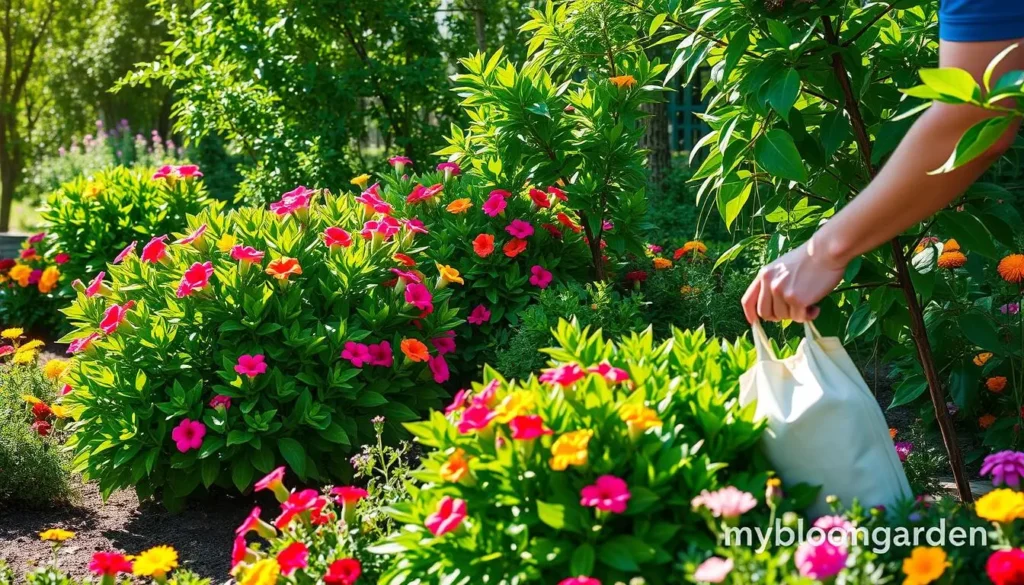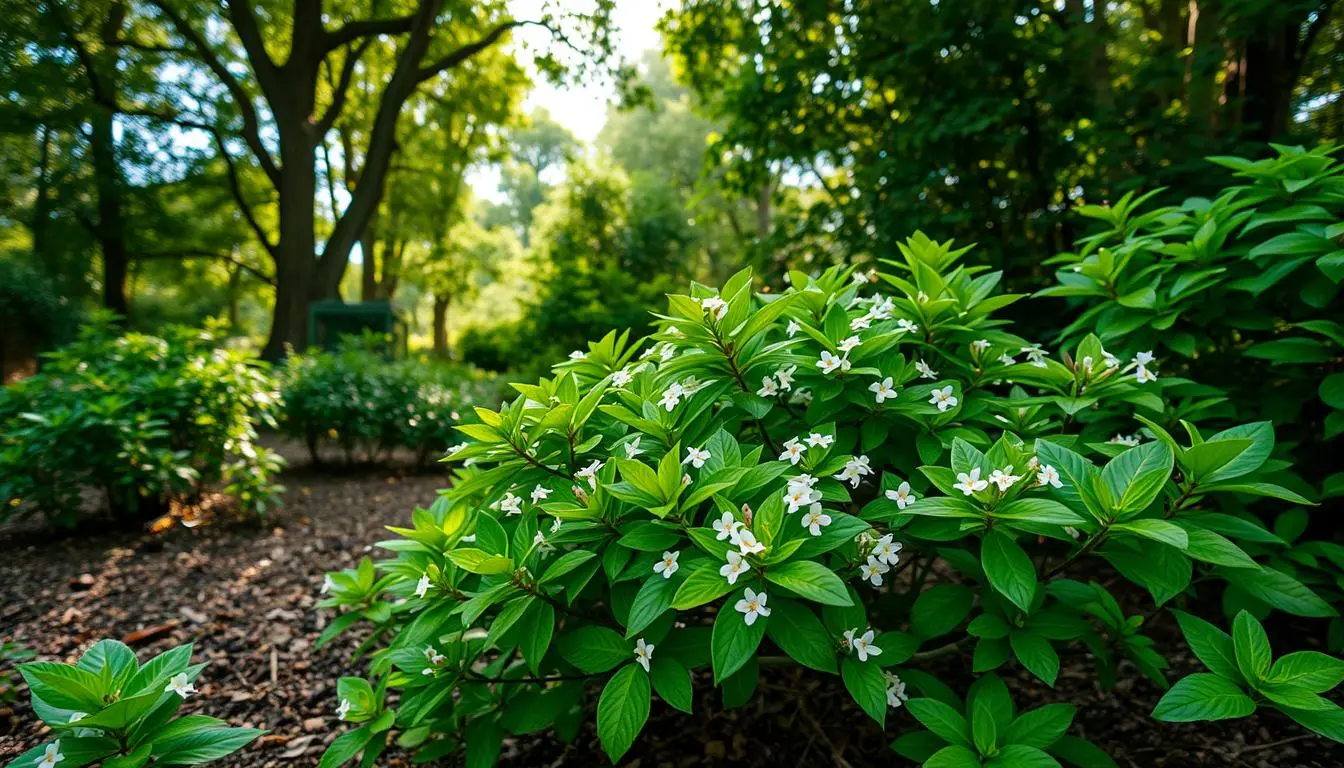Have you ever seen an Eugenia shrub in a garden or landscape? These plants are known for their glossy leaves and vibrant look. As a gardener, I’ve grown these shrubs and I’m eager to share my knowledge with you.
This guide will teach you how to grow Eugenia shrubs in your garden or on your patio. It doesn’t matter if you’re new to gardening or have experience. You’ll learn how to make your Eugenia shrub look amazing. You’ll get tips on pruning, shaping, and more to make your plant stand out.
Table of Contents
Understanding the Eugenia Shrub
Eugenia plants are a group of flowering shrubs loved by gardeners everywhere. They come from different places, each with its own look and growth. Knowing about Eugenia helps you pick the right ones for your garden.
Native Habitat and Natural Growth Patterns
The Eugenia family includes many species found in warm, humid areas around the world. They grow well in places like the Americas, Asia, and Oceania. Eugenia shrubs can be tall trees or small bushes, depending on where they grow.
Popular Varieties for Home Gardens
- Eugenia uniflora (Surinam Cherry): A small, bushy plant with shiny leaves and red, tasty fruits.
- Eugenia myrtifolia (Australian Brush Cherry): A versatile shrub with white flowers that smell like mint and small, purple-black berries.
- Eugenia x selloi (Grumichama): A bigger Eugenia known for its sweet fruits and lush look.
Benefits of Growing Eugenia Plants
Adding eugenia plants to your garden has many perks. They look good all year with their shiny leaves, flowers, and fruit. Eugenia plants are also great for hedges or as standalone plants. They grow well in many conditions, making them a good choice for gardeners.
“Eugenia shrubs add a touch of the tropics to any garden, with their lush foliage, fragrant flowers, and captivating fruits.”
| Eugenia Variety | Mature Size | Flower Color | Fruit Flavor |
|---|---|---|---|
| Eugenia uniflora | 6-10 ft tall | White | Sweet, tart |
| Eugenia myrtifolia | 15-25 ft tall | White | Mild, berry-like |
| Eugenia x selloi | 20-30 ft tall | White | Sweet, cherry-like |
Ideal Growing Conditions for Your Eugenia
To grow thriving trees and shrubs like Eugenia, knowing the best growing conditions is key. These drought-tolerant plants have certain needs. Meeting these can help them reach their full potential in your garden.
Eugenia shrubs love areas with lots of sunlight. They need at least 6 hours of direct sunlight a day. This makes them perfect for sunny spots. But, too much shade can cause them to grow weak and not bloom as much.
When it comes to temperature, Eugenia plants do best in warm, subtropical climates. They can handle temperatures from 50°F to 90°F (10°C to 32°C). This makes them adaptable to many areas. Yet, they may not do well in places with long, cold winters.
Keeping the right humidity levels is also important for Eugenia’s health. They do well in humid environments, with the best humidity between 40% and 60%. Dry air can cause leaf scorch and other problems. So, misting or using a pebble tray can help keep the air moist around your Eugenia plant.
By providing the right growing conditions, your Eugenia shrubs can thrive. They will become a stunning part of your drought-tolerant plants collection.
Soil Requirements and Preparation
To grow thriving low-maintenance shrubs like Eugenia, the soil must be just right. We’ll look at the best pH levels, drainage tips, and how to improve the soil. This will help your landscape shrubs grow well.
Optimal Soil pH Levels
Eugenia shrubs do best in slightly acidic soil. The ideal pH is between 5.5 and 6.5. This pH helps the plants take in nutrients well, leading to healthy growth and bright leaves. To check your soil’s pH, use a home test kit or ask your local nursery or cooperative extension service.
Drainage Considerations
- Eugenia shrubs need well-draining soil to avoid root rot from too much moisture.
- Make sure the planting area slopes or has drainage to keep water away from the plant’s base.
- If your soil is heavy or clay-based, mix in organic matter or sand to help with drainage and air.
Soil Amendment Tips
- Add 2-4 inches of compost or well-rotted organic matter to the soil before planting. This boosts nutrient levels and soil structure.
- If your soil pH is too high, use sulfur or aluminum sulfate to lower it to the right range.
- Use a slow-release balanced fertilizer to give your Eugenia shrub a steady supply of nutrients.
By understanding and meeting your Eugenia shrubs’ soil needs, you’ll grow thriving, easy-to-care-for plants. These will make your landscape even more beautiful.
Watering and Moisture Management
Keeping the right moisture levels is key for your eugenia shrub’s health. As drought-tolerant plants, eugenia need careful watering. This is especially true for eugenia topiary plants.
Finding the right balance in watering is crucial. Eugenia shrubs can handle some dryness but shouldn’t dry out completely. Keep the soil moist but not too wet.
- Water your eugenia shrub once or twice a week, depending on the climate and soil conditions.
- During hot, dry spells, increase watering frequency to ensure the soil does not become completely dry.
- When caring for eugenia topiaries, be extra vigilant about moisture levels, as the compact growth form can make the plant more susceptible to over or under-watering.
To keep moisture levels right, use mulch around the plant. It helps keep the soil moist and stops weeds. Check the soil moisture by sticking your finger into the ground. If the top inch or two feels dry, it’s time to water.
“Proper watering is the key to keeping your eugenia shrub healthy and vibrant. Establish a consistent routine to ensure the plant receives the right amount of moisture.”

Mastering watering and moisture management helps your drought-tolerant plants thrive. Enjoy the lush, green foliage of your eugenia shrub or topiary for years.
Pruning and Shaping Techniques
Keeping your Eugenia shrub healthy and looking good needs careful pruning and shaping. Knowing when to prune and how to shape your plants turns them into beautiful art. This shows off their natural beauty and fits your landscape design.
Seasonal Pruning Guidelines
Pruning Eugenia shrubs at the right time is crucial. Prune in late winter or early spring, just before new growth starts. This helps the plant heal fast and avoids diseases or pests.
Take out any dead, damaged, or crossing branches. This keeps your shrub healthy and balanced.
Topiary Shaping Methods
Eugenia plants are great for topiary shapes. Try shapes like cubes, spheres, or spirals for striking garden features. Keep your caring for eugenia topiary looking sharp by trimming regularly.
Tools and Equipment Needed
For precise pruning and shaping, you need the right tools. Get sharp bypass pruners, small hedge shears, and long-handled loppers for big branches. Use a pruning saw for thick stems and branches.
Learning to prune and shape Eugenia shrubs can make your garden stunning. With care and attention, your Eugenia will thrive. It will bring vibrant growth and beautiful leaves for years.
Fertilizing Your Eugenia Shrub
Keeping your low-maintenance evergreen shrubs like Eugenia healthy is important. Knowing what nutrients they need is crucial. This helps them stay vibrant all year.
Choosing the Right Fertilizer
There are different ways to fertilize your Eugenia shrub:
- Organic fertilizers, like compost or manure, slowly release nutrients. They help the soil and plant health over time.
- Synthetic fertilizers give a quick nutrient boost. But, it’s vital to follow the instructions to avoid too much.
Choose a fertilizer made for evergreen shrubs. This ensures your Eugenia gets the nutrients it needs.
Timing and Frequency
Fertilize your Eugenia in the spring when new growth starts. Use the fertilizer as directed, avoiding too much. Watch your plant’s growth and adjust as needed to keep it healthy.

By fertilizing your low-maintenance evergreen shrubs correctly, your Eugenia will stay beautiful for many years.
Common Pests and Disease Prevention
Keeping your eugenia plants, trees, and shrubs healthy is key for their growth and look. Knowing the common pests and diseases is the first step. This helps you prevent and fix problems quickly.
Identifying Common Issues
Common problems with eugenia plants include aphids, scale insects, fungal diseases, and leaf scorch. Spotting early signs like discolored leaves or pests is crucial. It lets you act fast to solve the issue.
Natural Treatment Solutions
- Use organic insecticidal soaps or horticultural oils to control aphids and scale insects.
- Apply a fungicide specifically formulated for eugenia plants to combat fungal diseases.
- Provide adequate water and shade to prevent leaf scorch during hot, dry periods.
Preventive Care Measures
To keep your eugenia plants, trees, and shrubs healthy, take preventive steps. Regularly check your plants, keep soil moist but well-drained, and prune to improve air flow. This proactive approach helps prevent pests and diseases. It ensures your eugenia plants will flourish for many years.
Propagation Methods and Tips
Expanding your collection of flowering shrubs and tropical plants is rewarding. Propagation is a great way to grow new plants from your existing ones. Eugenia shrubs can be propagated using a few effective techniques.
Stem Cuttings
Stem cuttings are a popular method. Choose healthy, vibrant stems from your Eugenia shrub. Cut just below a leaf node.
Dip the cut end in rooting hormone to help roots grow. Plant the cutting in a potting mix that drains well. Keep the soil moist and the cutting in a warm, shaded spot until roots appear.
Air Layering
Air layering is a more advanced technique. It involves wounding a stem on the parent plant. Then, wrap it with sphagnum moss and a plastic sleeve to promote root growth.
Once roots form, remove the stem and plant it as a new Eugenia shrub.
| Propagation Method | Success Rate | Difficulty Level |
|---|---|---|
| Stem Cuttings | 60-80% | Moderate |
| Air Layering | 70-90% | High |
Patience and attention to detail are crucial, no matter the method. With proper care, you can grow new Eugenia shrubs and expand your tropical plant collection.
Conclusion
The Eugenia shrub is a great choice for any garden. It’s not just beautiful; it’s also easy to care for. Knowing how to take care of it is important for its success.
Give your Eugenia shrub the right soil and water it regularly. Prune it often to keep its shape. Fertilize it to make sure it grows well and stays colorful.
The Eugenia shrub is a low-maintenance but stunning addition to any garden. With proper care, it will bring beauty to your outdoor spaces for many years.

